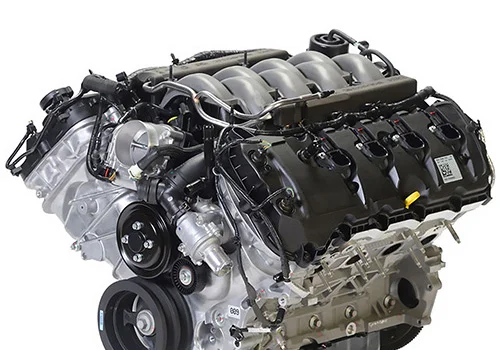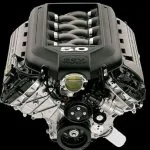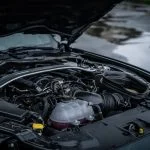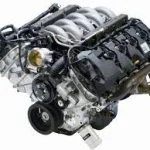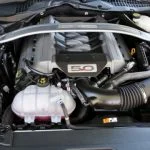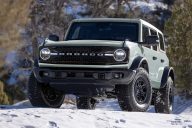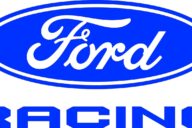The Ford 5.0L Coyote engine is a naturally aspirated V8 from Ford Motor Company used to power sports cars like the Ford Mustang and pickup trucks like the Ford F-150. It succeeds the 4.6L V8, which was Ford's first modular motor.
Quick Look
| Metric | Value |
|---|---|
| Engine family | Modular |
| Displacement | 5.0 liters |
| Aspiration | Atmospheric |
| Configuration & cylinders | V configuration, eight cylinders |
| Vehicle engine orientation | Longitudinal |
| Valve configuration | Dual overhead cam (DOHC) with variable camshaft timing (VCT) |
| Assembly sites | Windsor, Ontario |
| Predecessor | Ford 4.6L V8 |
| Successor | N/A |
Featuring a dual overhead cam (DOHC) design, in a V configuration, the Ford Coyote architecture has been part of the Ford Modular family since 2011. The engine has seen some revisions since then, the most recent being in 2018.
The Coyote V8 was first engineered for the Mustang GT in order to better compete with the GM 6.2L LS3 engine used in the Chevrolet Camaro at the time. In addition to offering more power, the then-new Coyote also had to retain the same dimensions as the outgoing 4.6-liter V8. Given the increase of nearly 100 horsepower between the 2010 and 2011 Mustang GT, it's safe the say that Ford reached its goal.
It's worth nothing that the Ford 5.0L Coyote V8 represented the automaker's first implementation of its Twin independent Variable Cam Timing (Ti-VCT) technology on a V8 engine, a feature which considerably improves fuel economy and power delivery while reducing emissions.
Vehicle Applications
The Ford 5.0L Coyote engine powered pickup trucks and coupes.
| Model Year(s) | Make | Model | Transmission | Drive Wheels | Power @ RPM | Torque (lb-ft) @ RPM |
| 2011 - 2014 | Ford | F-150 | 6-Speed Automatic | RWD / 4WD | 360 @ 5,500 | 380 @ 4,250 |
| 2015 - 2017 | Ford | F-150 | 6-Speed Automatic | RWD / 4WD | 385 @ 5,752 | 487 @ 3,850 |
| 2018 - 2020 | Ford | F-150 | 10-Speed Automatic | RWD / 4WD | 395 @ 5,750 | 400 @ 4,500 |
| 2021 - Present | Ford | F-150 | 10-Speed Automatic | RWD / 4WD | 400 @ 6,000 | 410 @ 4,250 |
| 2011 - 2012 | Ford | Mustang GT | 6-Speed Automatic / 6-Speed Manual | RWD | 412 @ 6,500 | 390 @ 4,250 |
| 2012 - 2013 | Ford | Mustang Boss 302 | 6-Speed Manual | RWD | 444 @ 7,500 | 390 @ 4,500 |
| 2013 - 2014 | Ford | Mustang GT | 6-Speed Automatic / 6-Speed Manual | RWD | 420 @ 6,500 | 390 @ 4,250 |
| 2015 - 2017 | Ford | Mustang GT | 6-Speed Automatic / 6-Speed Manual | RWD | 435 @ 6,500 | 400 @ 4,250 |
| 2018 - 2023 | Ford | Mustang GT | 10-Speed Automatic / 6-Speed Manual | RWD | 460 @ 7,000 | 420 @ 4,600 |
| 2021 - 2023 | Ford | Mustang Mach 1 | 10-Speed Automatic / 6-Speed Manual | RWD | 470 @ 7,250 | 410 @ 4,800 |
| 2024 - Present | Ford | Mustang GT | 10-Speed Automatic / 6-Speed Manual | RWD | 480 @ 7,150 | 415 @ 4,900 |
| 2024 - Present | Ford | Mustang GT w/ optional Active Valve Performance Exhaust | 10-Speed Automatic / 6-Speed Manual | RWD | 486 @ 7,150 | 418 @ 4,900 |
| 2024 - Present | Ford | Mustang Dark Horse | 10-Speed Automatic / 6-Speed Manual | RWD | 500 @ 7,250 | 418 @ 4,900 |
A supercharged variant of the Coyote V8 - known as the Miami V8 - was also utilized by seventh-generation Ford Falcon sedans and utes in the Australian market, specifically during the 2011 to 2016 model years. Notably, the Miami engine replaced the 5.4L Boss V8 for these vehicle applications.
Specs
| Metric | Value |
|---|---|
| Bore | 92.2 mm |
| Stroke | 92.7 mm |
| Compression ratio (2011-2017 Ford F-150) | 10.5:1 |
| Compression ratio (2011-2017 Mustang) | 11.0:1 |
| Compression ratio (2018+ Ford Mustang) | 12.0:1 |
| Compression ratio (2018+ Ford F-150) | 12.0:1 |
| Max power @ RPM | 460 @ 7,000 |
| Max torque @ RPM | 420 @ 4,600 rpm |
| Cylinder head | Aluminum |
| Cylinder block | Aluminum |
| Camshaft drive | Chain |
Production
For the North American market, the Ford 5.0L Coyote V8 engine is built at the Windsor assembly plant. Notably, the Coyote was also produced at the Romeo plant in Michigan before it shut down back in 2022.
Engine Family
The 5.0L Coyote V8 is part of the Ford Modular engine family - a series of V8 gasoline engines used in various vehicles.
Successor
The Coyote does not have a successor, and is currently still in production. That said, there are several iterations of the engine that are broken down into four generations. The fourth-gen 5.0L debuted in 2024 under the hood of the seventh-generation Mustang (aka S650).
A general overview of each generation with key highlights is shown below:
- First Generation: 2011 - 2014
- Second Generation: 2015 - 2017
- Addition of CMCV (Charge Motion Control Valve) a.k.a. IMRC (Intake Manifold Runner Control)
- Third Generation: 2018 - 2023
- Addition of high-pressure direct injection (low-pressure port injection retained)
- Fourth Generation: 2024 - Present
- Addition of dual throttle bodies
Discussion
Discuss the Ford 5.0L Coyote engine in our Ford forum.
News
Follow our coverage of Ford Mustang and Ford F-150 news.

